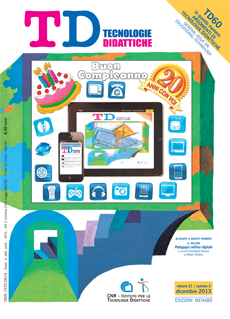La lezione con Powerpoint: gli studenti leggono o ascoltano?
Contenuto principale dell'articolo
Abstract
Dettagli dell'articolo
Sezione
Gli autori che pubblicano su questa rivista accettano le seguenti condizioni:
- Gli autori mantengono i diritti sulla loro opera e cedono alla rivista il diritto di prima pubblicazione dell'opera, contemporaneamente licenziata sotto una Licenza Creative Commons CC BY 4.0 Attribution 4.0 International License.
- Gli autori possono aderire ad altri accordi di licenza non esclusiva per la distribuzione della versione dell'opera pubblicata (es. depositarla in un archivio istituzionale o pubblicarla in una monografia), a patto di indicare che la prima pubblicazione è avvenuta su questa rivista.
- Gli autori possono diffondere la loro opera online (es. in repository istituzionali o nel loro sito web) prima e durante il processo di submission, poiché può portare a scambi produttivi e aumentare le citazioni dell'opera pubblicata (Vedi The effect of Open Access).
Riferimenti bibliografici
Adesope O.O., Nesbit J.C. (2012). Verbal redundancy in multimedia learning environments: A meta-analysis. Journal of pp. Educational Psychology, 104, pp. 250-263.
Antonietti A., Colombo B.(2008). Computer-supported learning tools: A bi-circular bi-directional framework. New Ideas in Psychology, 26, pp. 120-142.
Apperson J., Laws E., Scepansky J. (2008). An assessment of student preferences for powerpoint presentation structure in undergraduate courses. Computers and Education. 50, pp. 148-153.
Ausubel D. (1962). A subsumption theory of meaningful verbal learning and retention. Journal of General Psychology, 66, pp. 213- 214.
Bartsch R. Cobern K. (2003). Effectiveness of PowerPoint presentations in lectures. Computers Education, 41, pp. 77-86.
Bobis J., Sweller J., Cooper M. (1993). Cognitive load effects in a primary-school geometry task. Learning and Instruction, 3, pp. 1-21.
Brasel S., Gips J. (2011). Media multitasking behavior: concurrent television and computer usage. Cyberpsychology, Behavior, and Social Networking, 9, pp. 527-534.
Cantoia M., di Nuzzo C., Puglisi G., Scioli S., Serino S. (2011). I materiali didattici in Power Point: studenti e docenti a confronto. In Atti del IV convegno nazionale di Didattica della Psicologia (Facoltà di Psicologia, dell’Università degli Studi di Padova 25 - 26 febbraio 2011). http://convdidattica.psy.unipd.it/ (ultima consultazione 04.10.2013)
Chandler P., Sweller J. (1992). The split-attention effect as a factor in the design of instruction. British Journal of Educational Psychology, 62, pp. 233-246.
Chandler P., Sweller J. (1991). Cognitive load theory and the format of instruction. Cognition and Instruction, 8, pp. 293-332.
Clark R., Mayer R (2002). E-Learning and the Science of Instruction: Proven guidelines for consumers and designers of multimedia learning. Hoboken, NJ, USA: John Wiley Sons.
Farkas D. (2005). Understanding and using Power Point. Proceedings of the STC Annual Conference: Usability and Information Design, pp. 313-20.
Farkas D. (2006). Toward a better understanding of PowerPoint deck design. Information Design Journal + Document Design, 14 (2), pp. 162- 171.
Kalyuga S., Chandler P., Sweller J. (1999). Managing split-attention and redundancy in multimedia instruction. Applied Cognitive Psychology, 13, pp. 351–371.
Le Bohec O., Jamet E. (2008). Levels of verbal redundancy, note-taking and multimedia learning. In J. Rouet, R. Lowe, W. Schnotz (eds.). Understanding Multimedia Documents. New York, NY, USA: Springer, pp. 79-101.
Mayer R. (2001). Multimedia Learning. Cambridge, UK: Cambridge University Press.
Mayer R. (2005). The Cambridge handbook of Multimedia Learning. New York, NY, USA: Cambridge University Press, pp 159-167.
Mayer R., Johnson C. (2008). Revising the redundancy principle in multimedia learning. Journal of Educational Psychology, 2, pp. 380-386.
Media Management Center (2009). Teens know what they want from online news: Do you?. Arlington, VA, USA: API. http://www.americanpressinstitute. org/Research/Foundation/Youth- Content/Teens-Know-What-They-Want-From- Online-News.aspx (ultima consultazione 04.10.2013).
Moreno R., Mayer R. (2002). Verbal redundancy in multimedia learning: when reading helps listening. Journal of Educational Psychology, 92, pp. 724-733.
Ozuru Y., Kurby C., McNamara D. (2012). The effect of metacomprehension judgement task on comprehension monitoring and meta cognitive accuracy. Metacognition Learning, 7, pp. 113-131.
Paoletti G., Rigutti S. (2009). Efficacia di testi e presentazioni PowerPoint nella didattica Universitaria. In Domenici G., Semeraro R. (eds.). Le nuove sfide della ricerca didattica tra saperi, comunità sociali e culture. Roma, IT: Monolite.
Paoletti G., Rigutti S. (2010). Come presentare la tesi di laurea. Con PowerPoint, Impress, Google.docs i lucidi, la lavagna…. Roma, IT: Carocci.
Paoletti G., Bortolotti E., Zanon F. (2012). Effects of redundancy and paraphrasing in university lessons. Multitasking and cognitive load in writtenspoken PowerPoint presentation. In IJDLDC, 3 (3), Luglio-Settembre, pp. 1-11.
Paoletti G. (2012). Writing with Powerpoint. In D. Alamargot, M. Castelló, R. Llull, F. Ganier , O. Kruse, A. Mangen, L. Tolchinsky, L. Van Waes (eds.). Learning to write effectively: current trends in European Research. Bingley, UK: Emerald, pp. 325-327.
Sweller J. (2005). The redundancy principle in multimedia learning. In R. E. Mayer (ed.). The Cambridge handbook of Multimedia Learning. New York, NY, USA: Cambridge University Press, pp 159-167.
Tufte E. (2003). PowerPoint is Evil. On Newsstands Now, Issue 11.09. http://www.wired.com/wired/archive/11.09/ ppt2.html (ultima consultazione 06.09.2012).

